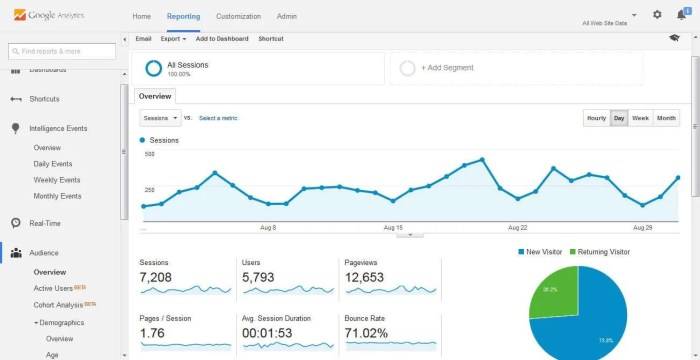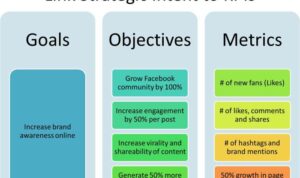Google Analytics Guide kicks off with a bang, diving into the world of website analytics to help you navigate the digital landscape like a pro. From understanding the importance of Google Analytics to setting up your account and interpreting data, this guide has got you covered. So, buckle up and let’s rock this analytics journey together!
Introduction to Google Analytics Guide
Google Analytics has become an essential tool for website owners looking to track and analyze their online presence. With its powerful features and benefits, Google Analytics provides valuable insights into website traffic and user behavior, helping businesses make informed decisions to improve their online performance.
Main Features and Benefits of Google Analytics
- Real-time data tracking: Google Analytics allows website owners to monitor their site’s performance in real-time, providing instant feedback on visitor activity.
- Audience insights: Gain a better understanding of your website visitors, including demographics, interests, and behaviors, to tailor your content and marketing strategies accordingly.
- Conversion tracking: Track key actions on your website, such as purchases or sign-ups, to measure the effectiveness of your marketing campaigns and website optimization efforts.
- Behavior flow analysis: Visualize how users navigate through your website, identifying drop-off points and areas for improvement to enhance the user experience.
- Custom reporting: Create customized reports and dashboards to focus on specific metrics that matter most to your business goals, providing actionable insights for growth.
Setting Up Google Analytics: Google Analytics Guide

To start using Google Analytics, you need to create an account and add the tracking code to your website. This will allow you to track various metrics and gain valuable insights into your website’s performance.
Creating a Google Analytics Account
- Go to the Google Analytics website and sign in with your Google account.
- Click on “Start for free” and fill in your account details, website name, and URL.
- Accept the terms and conditions and click on “Create” to generate your Google Analytics tracking ID.
Adding the Tracking Code to Your Website
Once you have your tracking ID, you need to add the tracking code to every page of your website that you want to track.
- Copy the tracking code provided by Google Analytics.
- Paste the tracking code before the closing tag of your website’s HTML code.
- Save and publish your website to start tracking visitor data.
Different Tracking Options in Google Analytics
- Pageviews: Tracks the number of times a page on your website is viewed.
- Events: Tracks interactions like clicks, downloads, and video views on your website.
- Goals: Sets specific actions you want users to complete on your website and tracks their completion.
Navigating the Google Analytics Dashboard
Navigating the Google Analytics dashboard is key to unlocking valuable insights about your website’s performance. The dashboard is divided into different sections, each offering specific metrics and reports to help you understand user behavior and track the success of your online presence.
Sections of the Google Analytics Dashboard
- The Real-Time Section: This section shows you live data on how users are interacting with your site at that moment. It includes information on active users, top pages, traffic sources, and conversions in real-time.
- The Audience Section: Here, you can find detailed information about your website visitors, such as demographics, interests, and behavior. You can also track new vs. returning visitors and engagement metrics.
- The Acquisition Section: This section provides insights into how users are finding your website. It includes data on traffic sources, campaigns, and s that are driving traffic to your site.
- The Behavior Section: This section focuses on how users are engaging with your website. You can analyze top-performing pages, site speed, events, and behavior flow to understand user interaction.
- The Conversions Section: This section allows you to track goal completions, e-commerce transactions, and other conversion-related metrics. You can set up goals and monitor the effectiveness of your marketing efforts.
Key Metrics and Reports in the Dashboard
- Sessions: The total number of sessions on your site, including both new and returning visits.
- Pageviews: The total number of pages viewed by users on your website.
- Bounce Rate: The percentage of single-page sessions where users leave your site without interacting further.
- Conversion Rate: The percentage of users who complete a desired action, such as making a purchase or signing up for a newsletter.
Customizing the dashboard can help you focus on the metrics that matter most to your business. You can create custom reports, dashboards, and segments to track specific KPIs and gain deeper insights into user behavior.
Interpreting Google Analytics Data

Analyzing website traffic data in Google Analytics is crucial for understanding how users interact with your site. By interpreting key metrics like bounce rate, session duration, and page views, you can gain valuable insights to improve your website’s performance and user experience.
Bounce Rate
The bounce rate in Google Analytics represents the percentage of single-page sessions where users leave your site without interacting further. A high bounce rate could indicate that visitors are not finding what they are looking for or that there are issues with the landing page.
- High bounce rates may require optimizing the content or improving the user experience to keep visitors engaged.
- Lowering bounce rates can lead to increased conversions and improved search engine rankings.
Session Duration
Session duration refers to the average amount of time users spend on your website during a session. Understanding session duration can provide insights into user engagement and content effectiveness.
- Longer session durations typically indicate that visitors are finding valuable content and spending more time on your site.
- Short session durations may require revisiting the content strategy to keep users engaged and encourage further exploration.
Page Views
Page views represent the total number of pages viewed by visitors on your website. Monitoring page views can help identify popular pages, visitor paths, and areas for improvement.
- Increasing page views can lead to higher engagement and more opportunities for users to interact with your content.
- Analyzing page views can help optimize website navigation, improve content placement, and enhance overall user experience.
Advanced Features of Google Analytics
Google Analytics offers a range of advanced features that can provide valuable insights into website performance and user behavior. Let’s explore some of the key features and how they can help you optimize your digital marketing strategies.
Goal Tracking, Google Analytics Guide
- Set specific goals for your website, such as form submissions, purchases, or page views.
- Track the completion of these goals to measure the success of your website and marketing campaigns.
- Use goal tracking to identify areas for improvement and optimize your website for better performance.
E-commerce Tracking
- Track e-commerce transactions on your website, including revenue, products sold, and customer behavior.
- Gain insights into customer purchase patterns, popular products, and revenue sources.
- Optimize your e-commerce strategy based on data-driven insights from e-commerce tracking.
Event Tracking
- Track user interactions with specific elements on your website, such as button clicks, video views, or downloads.
- Understand how users engage with your website and identify opportunities to enhance user experience.
- Use event tracking to measure the effectiveness of your website content and marketing campaigns.
Custom Reports and Dashboards
- Create custom reports in Google Analytics to analyze specific metrics and dimensions relevant to your business goals.
- Build customized dashboards to monitor key performance indicators and track progress towards your objectives.
- Tailor your reporting to focus on the metrics that matter most to your business and stakeholders.
Tracking Marketing Campaigns
- Use Google Analytics to track the performance of your marketing campaigns, including traffic sources, conversions, and ROI.
- Identify the most effective marketing channels and campaigns driving traffic and conversions on your website.
- Optimize your marketing efforts by analyzing campaign data and making data-driven decisions to improve results.





